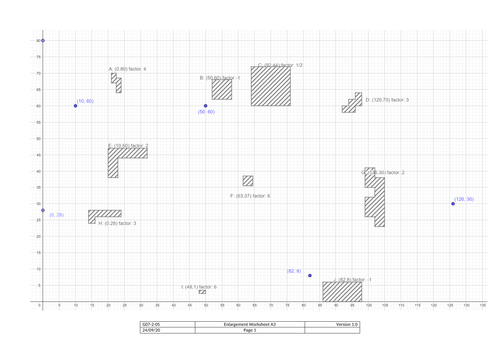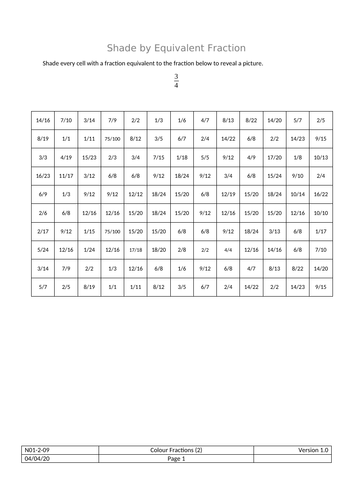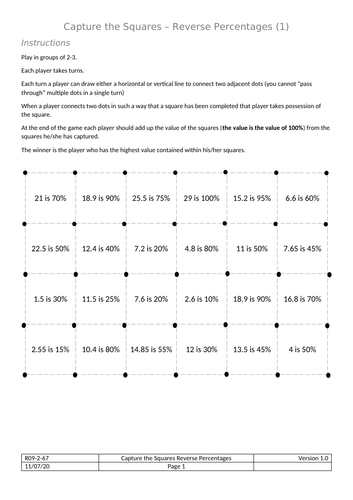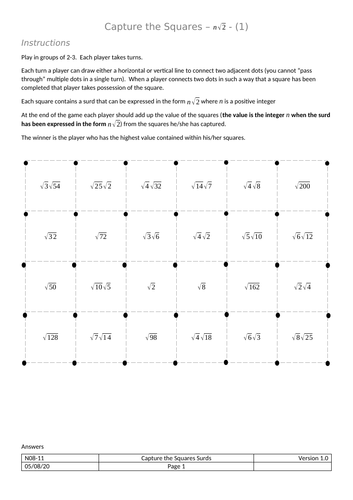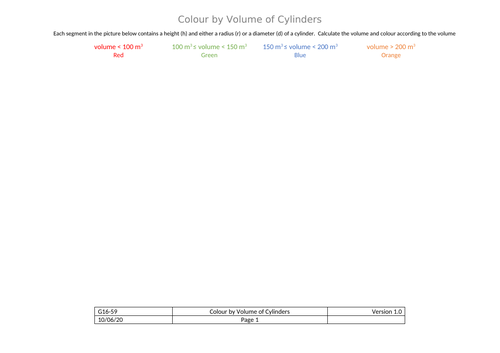
59Uploads
12k+Views
12k+Downloads
All resources

Colour by Percent of Amount (Calculator)
Calculate the percentage of an amount (calculator) of each expression and colour the segment accordingly.
Once completed a final question to answer is revealed.
This is specifically designed for lower ability groups as a more engaging alternative to a traditional worksheet or as a light revision activity for students of any ability level.
All questions within are integer percentages and all amounts are multiples of 10 (though most expression answers are decimals).

Shade by Ordering/Comparing Fractions
Shade (or don’t shade) the segments of the image based on whether fraction ‘a’ is greater than fraction ‘b’.
This resource also contains a second hidden hidden activity - shade the segments where both fraction ‘a’ and fraction ‘b’ are greater than 1/3.
This is a task intended for lower ability students or for students who are just learning to compare fractions. In each pair the denominators are multiples of each other (there are no co-prime pairs of denominator in any segment) so to compare ‘a’ and ‘b’ only requires one of the fractions to be converted into an equivalent.

Enlargement - Space Invader
An enlargment (with centre) worksheet. When enlarged the pieces form a “Space Invader”.
All co-ordinates are in the first quadrant. There are a couple of negative unit enlargements. The Geogebra file is included - however - should you wish to move everything to straddle the x & y axis.

Right Angled Triangles Mazes
Use Pythagoras’ theorem to verify whether 3 lengths can form a right angled triangle.
Move through each maze from cell to cell - only if the cell contains lengths that would form a right angled triangle.
Labelling conventions of sides used are random (c is not always the hypotenuse). Incorrect cells are designed to highlight common misconceptions in the application of Pythagoras’ theorem.

Capture the Squares - Midpoints
Players draw lines to complete squares. Whoever draws the last line captures the square. Each square contains co-ordinates for start & end points of a line segment and the co-ordinates of a midpoint. One ordinate value is missing.
The value of each square is the value of the missing number.
This activity is good for practicing fluency in a fun and engaging way.
The first worksheet includes only positive integers for the end points (midpoints can include a half). The second includes some negative integers. The third includes some negative fractional values for the co-ordinates of the start and end points.

Shade by Equivalent Fractions
Shade cells containing a fraction equivalent to the simplest form fractions to reveal a pixel image.
The worksheets become gradually more complex and are a moderately engaging fluency task.
The file names tell you what the image should ultimately show!

Snake Fractions Ordering
“Snake” through a 10x10 grid of fractions from the smallest to the largest (effectively putting all of the fractions in the grid into ascending order).
This is designed as a fluency task with a higher level of challenge. Often fractions that must be compared will have co-prime denominators.

Capture the Squares - Averages
Capture the squares is a game intended for 2-3 players. Each takes turns drawing a horizontal or vertical line. When the fourth line around a square is drawn on the page, the player who placed that line takes the square.
The maths twist is that the squares have different values. Players must solve the expression inside the square to find the value. In this case the value of squares is found by calculating the average of 3-5 values.
Worksheets escalate in difficulty. Starting with positive & negative integers and then moving through 1/2 fractions and then onto fractions/decimals as small as 1/4 increments.

Capture the Squares - Reverse Percentage
Players draw lines to complete squares. Whoever draws the last line captures the square. The value of each square is hidden but an expression about the value of a percentage is given. Players use reverse percentages to work out the true value and strategise to capture the highest value squares.
This activity is good for practicing fluency in a fun and engaging way.
All reverse percentages in this worksheet are multiples of 5% and designed to be worked out without a calculator. All answers are integers but the values given are typically decimals so many students may find this quite challenging.

Capture the Squares Surds
A series of ‘capture the squares’ games where the square value is the integer ‘n’ when the surd has been converted into the form ‘n root 2’ or ‘n root 3’
Can be used to consolidate learning or as bell work.
For both root 2 and root 3 there are two games. One has just mulitplication of surds and the other has addition, division and multiplication of surds by integers.

Wheels - Solving Linear Equations
The inner and outer wheels combine to form 3 different equations. Turn the inner wheel to change the combinations and generate 3 different equations. Find the wheel setting that results in all three equations solving for the same value.
The first set of wheels are simple 2 step linear equations. The second set of wheels involve brackets. The third set of wheels includes variables on each side of the equation.
I’ve made each resource twice - once designed to be just printed and once where the inner wheels can be cut out and pinned to the outer wheels using paper fasteners (solutions can be found in the “cutting version”)
My main motivation in making this resource was to present a rich problem solving activity for the topic in a visually novel format. There are a couple of extension questions for high ability students to consider.

Dials - Values of Digits - Integers
Use the clues to set each dial to the correct answer. Often individual dials can be set to two or more possible settings but each group of three has only one correct “setting”.
This particular worksheet is focused on understanding the value of digits and includes questions in which the numbers are stated in words.
Answers are provided in the powerpoint file (but this is not animated).

Coins search
Like a word search - but with coins.
Find a total amount by drawing a horizontal, vertical or diagonal line through 3, 4, 5 or 6 consecutive cells.
The worksheet has questions of increasing difficulty and includes a set of possible solutions (there are other options for some of the questions). Also includes a PowerPoint that has the solutions highlighted on it.

Colour by Volume of Cylinders
Colour each segment of the image according to the volume of the cylinder described within.
Particularly designed for students who struggle to engage with traditional worksheets but approrpriate for any students seeking light revision.

Capture the Squares Ratio Simplification
A series of ‘capture the squares’ games where the square value is the missing number in a ratio to simplify.
Can be used to consolidate learning or as bell work.
Games start basic but later ones build to include three part ratios.

Colour by Distance Between Co-Ordinates
Each segment contains two co-ordinate pairs. Work out the distance between the two using Pythagoras’ theorem and colour the segment according to this distance.
The resource does allow for co-ordinates in all 4 quadrants and may therefore challenge foundation level students but all triangles are Pythagorean triples with integer value lengths for the hypotenuse.

Capture the Squares Distance Between Co-Ordinates
A couple of ‘capture the squares’ games where the square value is the distance between the two co-ordinates within the square (to be calculated using Pythagoras’ theorem).
Can be used to consolidate learning or as bell work.
Both games feature co-ordinates in all 4 quadrants. The first game has only integer co-ordinates and basic Pythagorean triple triangles. The second game still uses only basic Pythagorean triples but some are scaled to half or 3/2 and some of the co-ordinates may be decimal.

Capture the Squares Factors
A couple of ‘capture the squares’ games where the square value is the number of factors of the number within the square.
Can be used to consolidate learning or as bell work.

Numbersearch Fractions Addition
Like a wordsearch but with fractions.
Find a total amount by drawing a horizontal, vertical or diagonal line through 3, 2, 3 or 4 consecutive cells.
The worksheet has questions of increasing difficulty (the first numbersearch has only fractions with a denominator of 2, the second has only fractions with denominators of 2, 4 and 8, the third has only denominators of 3, 6 and 9 whilst the last has 2, 3, 4 & 6 making finding a common factor slightly trickier).
Everything should be differentiated - with lower ability students able to find the “2 numbers that add together to make” questions whilst higher ability students can tackle the “4 numbers that add together to make” questions.

Capture the Squares Linear Equations
A series of ‘capture the squares’ games where the square value is the missing x or y co-ordinate when the linear equation of y = mx + c is given.
Can be used to consolidate learning, revision or as bell work.
Games start basic and increase gradually in difficulty.
I have published many similar capture the squares games here on TES for other topics. I believe they offer a flexible revision activity.



